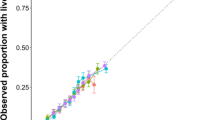Abstract
Purpose
Evaluating the failed IVF cycle often provides useful prognostic information. Before undergoing another attempt, patients experiencing an unsuccessful IVF cycle frequently request information about the probability of future success. Here, we introduced the concept of reproducibility and formulae to predict the next IVF cycle outcome.
Methods
The experimental design was based on the retrospective review of IVF cycle data from 2006 to 2013 in two different IVF centers and statistical analysis. The reproducibility coefficients (r) of IVF traits including number of oocytes retrieved, oocyte maturity, fertilization, embryo quality and pregnancy were estimated using the interclass correlation coefficient between the repeated IVF cycle measurements for the same patient by variance component analysis. The formulae were designed to predict next IVF cycle outcome.
Results
The number of oocytes retrieved from patients and their fertilization rate had the highest reproducibility coefficients (r = 0.81 ~ 0.84), which indicated a very close correlation between the first retrieval cycle and subsequent IVF cycles. Oocyte maturity and number of top quality embryos had middle level reproducibility (r = 0.38 ~ 0.76) and pregnancy rate had a relative lower reproducibility (r = 0.23 ~ 0.27). Based on these parameters, the next outcome for these IVF traits might be accurately predicted by the designed formulae.
Conclusions
The introduction of the concept of reproducibility to our human IVF program allows us to predict future IVF cycle outcomes. The traits of oocyte numbers retrieved, oocyte maturity, fertilization, and top quality embryos had higher or middle reproducibility, which provides a basis for accurate prediction of future IVF outcomes. Based on this prediction, physicians may counsel their patients or change patient’s stimulation plans, and laboratory embryologists may improve their IVF techniques accordingly.

Similar content being viewed by others
References
Adamson GD, de Mouzon J, Lancaster P, Nygren KG, Sullivan E, Zegers-Hochschild F. World collaborative report on in vitro fertilization, 2000. Fertil Steril. 2006;85:1586–622.
Robertson DM. Predictors of IVF outcome: markers and protocols. Women’s Health. 2006;2:385–8.
Maheshwari A. BhattacharyaS. Johnson NP Predicting fertility Human Fertility. 2008;11:109–17.
Leushuis E, van der Steeg JW, Steures P, Bossuyt PMM, Eijkemans MJC, van der Veen F, et al. Prediction models in reproductive medicine: a critical appraisal. Human Reproduction Update. 2009;15(5):537–52.
Fisch J, Sher G, Adamowicz M, Keskintepe L. The graduated embryo score predicts the outcome of assisted reproductive technologies better than a single day 3 evaluation and achieves results associated with blastocyst transfer from day 3 embryo transfer. Fertil Steril. 2003;80:1352–2358.
Trounson AO, Gardner DK. Handbook of In Vitro Fertilization -2nd ed. CRC Press, LLC. New York. 2000; pp 68; p173-174.
Carstensen B. Repeatability, Reproducibility and coefficient of variation, in comparing clinical measurement methods: A practical guide, John Wiley & Sons, Ltd, Chichester. UK. 2010. doi:10.1002/9780470683019.ch9.
Roman RM, Wilcox CJ, Martin FG. Estimates of repeatability and heritability of productive and reproductive traits in a herd of Jersey cattle. Genetics and Mol Biol. 2000;23:113–9.
Loughman J. The statistical interpretation of the coefficient of repeatability. Br J Ophthalmol. 2010;94:753–6.
Soullier N, Bouyer J, Pouly JL, Guibert J, de La Rochebrochard E. Estimating the success of an in vitro fertilization programme using multiple imputation. Human Reproduction. 2008;23:187–92.
Sullivan E. Single embryo transfer reduces the risk of perinatal mortality in IVF. Medical Press 2012; http://medicalxpress.com/news/2012-07-world-ivf-icsi-babies-total.html.
Westhoff C, Murphy P, Heller D. Predictors of ovarian follicle number. Fertil Steril. 2000;74:624–8.
Ireland JJ, Ward F, Jimenez-Krassel F, Ireland JLH, Smith GW, Lonergan P, et al. Follicle numbers are highly repeatable within individual animals but are inversely correlated with FSH concentrations and the proportion of good-quality embryos after ovarian stimulation in cattle. Human Reproduction. 2007;22:1–9.
Author information
Authors and Affiliations
Corresponding author
Additional information
Capsule The IVF traits including number of oocytes retrieved, maturity, fertilization and top quality embryos had high or middle reproducibility. Base on these parameters, the outcomes of these traits could be accurately predicted in next IVF cycle.
Rights and permissions
About this article
Cite this article
Wu, B., Shi, J., Zhao, W. et al. Understanding reproducibility of human IVF traits to predict next IVF cycle outcome. J Assist Reprod Genet 31, 1323–1330 (2014). https://doi.org/10.1007/s10815-014-0288-y
Received:
Accepted:
Published:
Issue Date:
DOI: https://doi.org/10.1007/s10815-014-0288-y




